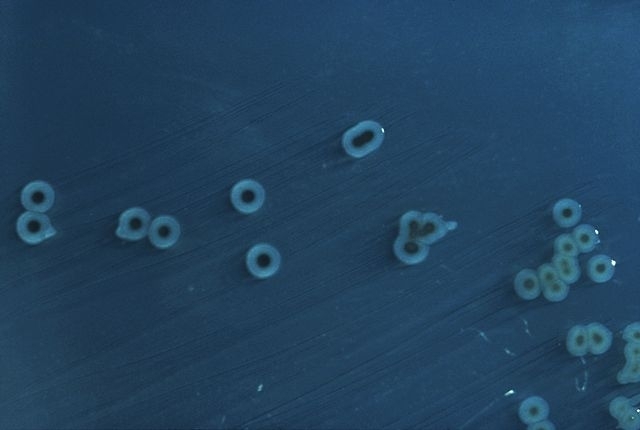

Salmonella enterica produces a protein similar to macroglobulin, which plays a key role in the human immune system. The article was published in Nature Communications (image of a Salmonella enterica colony: CDC/Wikimedia)
Salmonella enterica produces a protein similar to macroglobulin, which plays a key role in the human immune system. The article was published in Nature Communications.
Salmonella enterica produces a protein similar to macroglobulin, which plays a key role in the human immune system. The article was published in Nature Communications.

Salmonella enterica produces a protein similar to macroglobulin, which plays a key role in the human immune system. The article was published in Nature Communications (image of a Salmonella enterica colony: CDC/Wikimedia)
By Karina Toledo
Agência FAPESP – A study published in the journal Nature Communications has revealed that the Salmonella enterica bacterium is able to produce a protein that is very similar to the human alpha-2-macroglobulin, which plays a key role in our immune system.
The hypothesis proposed by researchers at the Institute of Structural Biology (IBS) in Grenoble, France, is that bacterial macroglobulins may be part of a rudimentary defense system. If the theory is confirmed by additional studies, these proteins may be used as a target to develop new antibiotics.
“What’s most fascinating is that macroglobulins are huge proteins, composed of nearly 1,700 amino acid residues. If the bacteria synthesize a molecule that big, that molecule must play a very important role,” said Brazilian IBS researcher Andréa Dessen, who is also the coordinator of a FAPESP-funded study through the São Paulo Excellence Chairs (SPEC) program at the Brazilian Biosciences National Laboratory (LNBio) in Campinas.
In the human body, alpha-2-macroglobulin’s mission is to detect and neutralize proteases secreted by invading microorganisms, said the researcher. Proteases are enzymes that break down proteins into amino acids.
“Thus, macroglobulins prevent the invader proteases from destroying the body’s tissues, which would allow infection of deeper tissues,” she explained.
In addition, alpha-2-macroglobulin also binds to proteases that take part in the process of blood clotting, preventing important proteins from being unduly destroyed.
In previous studies in which the genomes of several species of bacteria were sequenced, German researchers had already observed the presence of the macroglobulin gene. At the IBS, the group led by Dessen had previously conducted biochemical characterizations of the proteins produced by the species Escherichia coli and Pseudomonas aeruginosa.
“Now, for the first time, we are studying the three-dimensional structure of the macroglobulin secreted by Salmonella enterica using a technique known as X-ray crystallography, which allows us to see details at an atomic level. We can actually confirm that it is very similar to human macroglobulin,” Dessen said.
According to the researcher, the discovery supports the hypothesis that alpha-2-macroglobulin has a role in protecting the bacteria from the proteases secreted by other bacteria or by the host organism that they are trying to infect.
“In a mouse model, Canadian researchers have demonstrated that strains of the Pseudomonas aeruginosa bacterium that do not produce macroglobulin have a decreased capacity to cause disease, or, in other words, are less virulent. The protein seems to give bacteria a certain advantage when they colonize a host, but we still do not know exactly why,” she said.
Discoveries
In an offshoot of the research that is being carried at out the LNBio, with support from FAPESP and under the direction of Dessen, French post-doctoral candidate Samira Zouhir is investigating the structure of the macroglobulin synthesized by the species Pseudomonas aeruginosa, which has caused several cases of hospital infections.
“If we can unravel the three-dimensional structure of the protein, it would give us clues about its function in the infectious process,” Dessen said.
Once the role of macroglobulins is clearly understood in different species of bacteria, she added, these proteins could be used as targets in the development of new antibiotics.
“There are also interesting studies in mouse models that show that use of human alpha-globulin may offer protection against sepsis. There are several treatment possibilities to be explored,” the researcher noted.
The article, “Structure of bacterial α2-macroglobulin reveals mimicry of eukaryotic innate immunity” (doi: 10.1038/ncomms5917), can be accessed at www.nature.com/ncomms/2014/140915/ncomms5917/full/ncomms5917.html.
Republish
The Agency FAPESP licenses news via Creative Commons (CC-BY-NC-ND) so that they can be republished free of charge and in a simple way by other digital or printed vehicles. Agência FAPESP must be credited as the source of the content being republished and the name of the reporter (if any) must be attributed. Using the HMTL button below allows compliance with these rules, detailed in Digital Republishing Policy FAPESP.




